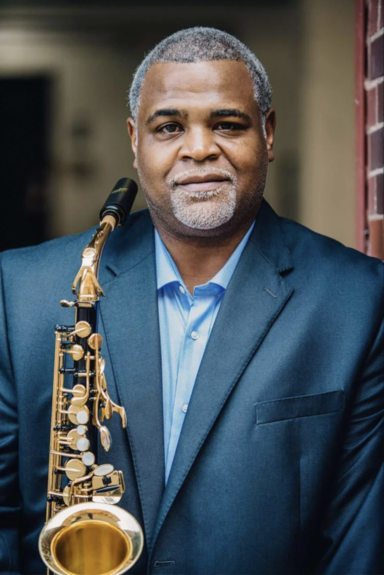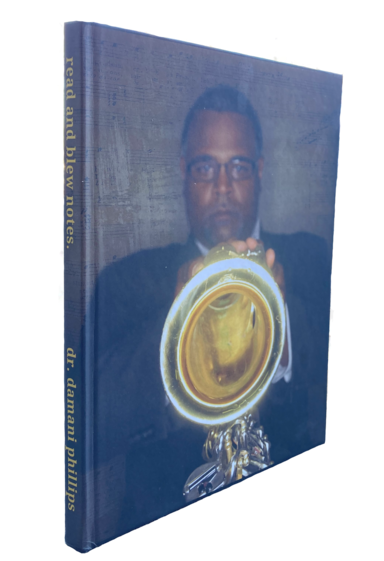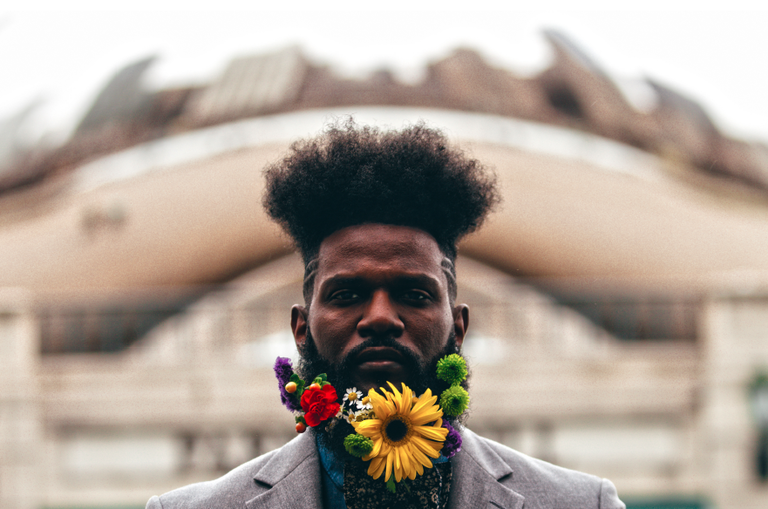
In November 2023, Damani Phillips (School of Music and African American Studies, CLAS) and spoken-word artist Brandon Alexander Williams released the world's first "listening book," Read and Blew Notes. A new medium intended to replace physical music products like CDs and download cards, the "L.B." brings back the ritual experience of listening to new music with a physical product in hand. The book includes album liner notes, full musical scores, and interviews with artists on how their music came into being. The Obermann Center was proud to support the project through co-sponsorship funding.
Damani Phillips serves as head of the Jazz Studies area and Associate Professor of African-American Studies at the University of Iowa, where he teaches applied jazz saxophone, directs large/small jazz ensembles, and teaches courses in African-American music, African-American culture, jazz education, and improvisation.
Katie Buehner, Director of the UI's Rita Benton Music Library, recently interviewed Dr. Phillips about the book:
KB: You describe this as a "listening book."
DP: That's the best descriptor that I can come up with for it—and it was very much intended to be a replacement for the ritual of us having a physical product in our hand as we listened. As I grew up, those were some of my favorite memories—me sitting there with, once upon a time, a cassette and then after that, a CD. Having that physical product in my hand as I listen to the music and getting an inside perspective on what's going on with the music, you know? That experience was really transformative and, even to this day, a big part of what I look for when listening carefully and intently to things. And with the advent of streaming—obviously, that's kind of gone the way of the dodo. It’s no longer something that's customarily done. But I think some important things are lost as we make that transition. I know it's convenient to have music piped into your phone, but there are some things that get lost in the wash, so to speak, as we make that change away from physical product into something that's purely digital.

KB: In this book, you have an overview of every item, every track that you describe. So there’s a musical track that sort of forms a chapter. And then you have the musical score, and then you have an interview with Brandon Alexander Williams, who was a Grant Wood fellow here a couple of years ago. It’s the two of you talking about each track. Sometimes it sort of heads toward a topic related to the track, then you can link out to media file of the track itself. So there's a lot of things included—a kind of “surround sound” experience.
DP: Yeah, absolutely. It was kind of built on the notion of all the things that I would love to have had from the artists that I love. I want to know the story behind the album that the song originally appeared on. I would love to see the actual score of what's going on in the music. I would, of course, love to have the music [song audio] itself. But more importantly, it's those gems of old interviews that we find from Cannonball, or Coltrane talking about topics in their own words, as opposed to us taking a scholarly approach and trying to surmise what they intended or what they meant [in their music]. Actually getting to hear it from their own mouth in their own words and in their own language, as casual or as formal as they want it to be. Where you actually get to know the artist in a way that you can't do if you just deal with a physical product or medium. So we kind of put together a list of all the things that we would love to have about every song that we heard.
KB: So you collaborated with Brandon Alexander Williams on this project?
DP: Absolutely. And like you said, Brandon was our Grant Wood Fellow here in hip hop performance several years back. He and I stayed in touch over the years after he finished his fellowship, and he contacted me with this idea. So this was really his brainchild. I know he has some books that are similar in construction for his [spoken word] poetry, but he contacted me and said, "I've got this great idea. I'd like to use you as a bit of a guinea pig." So we sat down, he gave me the idea, and we brainstormed in terms of what it should be—what should be included. Then we came up with the listening book. But it is entirely his idea. Absolute genius! I think he realizes, too, that us trying to insist on digital [streamed] media [exclusively] has got its limitations. It's convenient, it's fast, and it fits a young lifestyle—but, at the same time, some things are lost in translation. So the listening book was a way of having our cake and eating it, too. Still a digital medium—because we are not going to be able to fight that. That is what it is, and people are going to consume music through their electronic devices from now until the end of time. Just the way it's going to be. But at the same time, [the listening book can] still provide the other side of things that I think helps make the experience of enjoying people's musical work that much more of an immersive thing.
KB: We were talking about this in the library workroom—people's use of liner notes. When we have students coming in to check out CDs, almost always, they're very eager to look at the liner notes because that type of information is not as readily available as it used to be. You might learn about an artist that doesn't have much of a presence online. You'll learn about how the album was conceived, what the idea was. But your book is so much more than liner notes. It's far more full-bodied than that.

DP: Well, that was the hope. Like I say, we wanted to give as much information as possible. One of the beautiful aspects of this format is that you can put pretty much as much information in there as you want without being taxing on the medium. You can put 150 pages in there if you really want to. So we took full advantage of that without overwhelming the listener with stuff just for the sake of having stuff. At the same time, if you get to experience my listening book, you should know me pretty well by the time it's all said and done with.
KB: You definitely share pieces of your history, experiences from your playing and your education—and you share your philosophy of how you approach what you do. Brandon's a really good interviewer!
DP: It definitely stays casual, but he kind of teases things out of you that you might not say if it was a formal interview. It ended up being just two folks having a conversation. That was really the point, too—the casualness of it all.
KB: The conversational tone is really lovely. He's not somebody who reads music on the regular, and obviously, you've been reading music for a very long time and you sort of have that conversation: here in the scores there's this, and how did you make this decision to do this?
DP: That was a part of the concept, too. In my mind, I saw a parent and child sitting next to each other where the parent has musical training and the child doesn't. They then have a conversation: This is what happens here [pointing to music score], and this is what a chord looks like. Those conversations where they get to know the craft of music—not just the music [audio] that's inside the book. Making listening an experience as best as humanly possible—not just for a specific kind of demographic or specific constituency, but for everyone! We tried to put something in there that pretty much everybody can relate to. If you know nothing about music, then get into the interviews. If you're a music buff, then dive into the [written music] scores. For my string charts [songs arranged for jazz quartet + strings], I literally put the entire score there so you can see exactly how I wrote those tunes—the voicings, the way things moved [musical counterpoint], all that stuff. If you're a music [audio] buff, then scan the QR code and go check out the track if that's all you're after. Something for everybody—with the hope that not only will people be able to enjoy the music, but also share the experience of listening to the music. I think that’s the best way that I can describe it. So that [listening] is an experience that we collectively have, as opposed to me with my device in my hand through my Spotify or whatever account. Us! Let's get together and listen to this. Bringing that communal spirit back to the process of listening like it was when I was young. We would all get together and have listening sessions and rap back and forth [about the music we were hearing]. Hopefully we can, at the very least, rekindle that—or, at or at minimum, demonstrate the value of that.
KB: So for this publication, you were really in charge because it's your publication. You made it all happen from the ground up.
DP: Yeah. Brandon gave me the idea, and then we definitely riffed back and forth about what to put in the book. I made an argument for all the things that we put in there. So, in that regard, we kind of collaborated on it. He wasn't a musician [in the traditional trained sense]. He didn't really think to himself what would be ideal for this book [from a trained musician’s perspective]. He was thinking about it from one angle, and I was thinking about it from the perspective of somebody who's been playing and listening to music my whole life. We came together and settled on this particular format by the time the whole process was done.
KB: You've done a book of interviews with a publisher: What Is This Thing Called Soul: Conversations on Jazz and Black Culture. What did you enjoy about the experience of really being able to make all the decisions yourself? What was it about this, your listening book, that was different to you in a way that that made you happy you went that route?
DP: In the beginning it's just an idea, and it's kind of theoretical. It may possibly work out that A, B, and C happen [according to a plan]. As it came together, I was like “Ohhhh!” It’s only then that it starts to come to reality. The process of seeing people enjoy it starts to get closer and closer to fruition. That was the thing that warmed my heart because I knew that we had a winner. When the physical product—the draft copy of it—landed in my hand, I was like, my goodness. We've got a monster on our hands! It has literally taken off. [With] new mediums, you are always a little bit worried, but folks have taken to this like fish to water. Some people put the listening book on their table, make it a conversation piece. Some people like to use it in the way that it's supposed to be used—right next to people [while] listening. Regardless of what your focus is or what you feel is important, the book can provide it. In order for us to get away from the purely digital [streaming] approach, we've got to offer something that is alluring and attractive. That's convenient to use, but not cumbersome to the point where it's a pain in the in the backside to actually access the music that way. So there's a lot of smart thinking that has to go into what you want to use if you want to legitimately bring this [physical products] back. Like I said, Brandon's idea was literally genius. I thought it might be until I got it in my hands. Once that happened I was like, yeah, this is something that has the ability to really change the game. It seems, at least from public reception so far, that it definitely has the ability to be a legitimate presence in how we offer music to the public.
KB: Will you will you pester Curtis Taylor and William Menefield [colleagues on the UI jazz studies faculty] to give it a whirl?
DP: Well, I presented the listening book concept to the entire jazz program, so they know exactly what happened with the book and how it was conceived from top to bottom. So I'm hoping that they may at some point consider it, too. As the book's success builds and I share that with them, I hope that they'll see that it's got more appeal than it may appear to have on the surface. In thinking a little bit bigger, now that we have this presented in book format, you can get this into bookstores. You can get it into libraries, where it's not with the other CDs way back in the back of the library somewhere that you have to have a call number….
KB: I can't buy a digital recording by a single title and distribute it via a library, but we can have this listening book on the shelf.
DP: That is the hope. I'm also thinking about students. [For instance], here we have our DMA recording project. Part of that's a paper, and part of that's recording. This is the perfect medium for that. So there's lots of applications that are well beyond offering albums. I think folks are so locked into their way of thinking about how we consume music customarily now that they aren't even really considering the other possibilities beyond literal thinking.
KB: The title, “Read and Blew Notes”—I had to look at it a couple of times… that's clever! Where did it come from?
DP: The wordsmith himself.
KB: It came from Brandon! He's so clever.
DP: It most certainly did! He snuck that one in on me, too! He didn’t tell me about it. I just looked at it and was like, “Ohhhhh!” And what are you going to say about that, you know? Am I going to tell him no? Of course not. It's so very, very slick.
KB: If somebody wanted to get their hands on a copy, how would they go about doing that? You also mentioned that it's available in a couple of different formats.
DP: Absolutely. My thing was, if we're going to use this as a possible replacement for how we offer music to the public, then the price point needs to be something that's at least commensurate with what we would pay if we were to purchase a CD. So there are three different versions of it. There's a black-and-white version and a color copy. Both of those are soft-bound. There's also a hardbound copy, which is a little nicer, for people who want something that's a little more substantive. The price point of the black-and-white copy is right at the same price you pay for a CD, $20. So I can take these to shows, and I can offer people either a digital download card where they go and they download MP3 files from a server and have it on their phone, or I can offer them the actual listening book. It's really easy to get these. You can get them directly from me, but you can also go to Amazon. If you type in "Damani Phillips" and "Read and Blew Notes," they'll pop right up.
KB: I really enjoyed the time I’ve spent with the book. I love seeing when faculty get creative with their projects, and this is really something special.
DP: I'm hoping so! And I'd be remiss if I didn't mention the Obermann Center. It doesn't fit the normal mold of a book in the traditional academic sense, so it's not something that the university readily supported as we were trying to get the project off the ground. If I were recording an album, obviously the university supports that, but for this it was [viewed as] just a self-publication. The Obermann Center was one of the few places on campus that actually believed in this concept and supported it to allow me to at least put the prototype together and place it in people’s hands. Once that happened, the whole trajectory of things changed completely. So I am truly thankful to them for that support because it was definitely instrumental in helping to bring this idea to fruition.